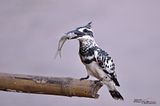It's been a long time since the last post! I've become really busy recently and didn't even have time for birding. Finally, I've got enough time and mood to update this blog, so here we are, March 17, our first full day birding in Merapoh. We started very early in the morning. It was around 7am and the sun hasn't come up yet, when I walked out of the room and saw a variant male Black Hornbill (Anthracoceros malayanus) feeding in a fruiting fig tree just in front of the house! I quickly grabbed my gear and tried to shoot it despite the very low light. I guessed it was the same bird I photographed the day before. The bird hanged around for a while, and even came down to the eye-level branches to pick up fruits, before flying out into the forest. It's really difficult to watch hornbills closely like that in Thailand, so I was really impressed.



Variant male Black Hornbill (Anthracoceros malayanus)



Puff-backed Bulbul (Pycnonotus eutilotus)
The fruiting tree was actually very productive! We saw many flocks of Brown Barbets and Asian Glossy Starlings, and of course, lots of bulbuls. A few Lesser Green Leafbirds were also joining the feast, as well as a large and colourful Gold-whiskered Barbet which briefly appeared along with a group of the smaller Brown Barbets. As for the bulbuls, there were many Buff-vented Bulbuls, some Red-eyed, Spectacled and Streaked Bulbuls and a pair of Puff-backed Bulbuls (Pycnonotus eutilotus), undoubtedly the most interesting one. I've always wondered why it's got the name puff-backed and I finally got a chance to witness it myself while the birds were resting on the nearby tree. The feathers on their back were really puffy! Very interesting!
After enjoying the morning feast at the fruiting fig tree in front of our house, I decided to walk along the road leading into the forest. The very first bird I saw was a pair of tiny, yet colourful, Chestnut-winged Babblers (Stachyris erythroptera). They were moving under the dense ferns, but responded very well to the playback. After getting some good shots, I stopped using the tape to prevent the birds from gaining more stress. Other birds around the area included many Hairy-backed Bulbuls, Yellow-bellied Bulbuls and a few skittish Grey-cheeked Bulbuls (Alophoixus bres tephrogenys).




Male and female Scarlet-rumped Trogon (Harpactes duvaucelii)



Male Grey-And-Buff Woodpecker (Hemicircus concretus sordidus)
However, the real peak time of the day began when the sun finally shown up above the canopy. I spotted a shy female Scarlet-rumped Trogon (Harpactes duvaucelii) joining in a flock of bulbuls. It was surely my first lifer of the day! The female bird was later accompanied by the very brightly coloured male, which came perching just in front of me! Its extremely bright scarlet red plumage stood out very clearly among the dark green setting of the rainforest. With that colour, you just can't hide very well. There were many other birds that I couldn't get any pics around as well, including the colourful Raffle's Malkohas, Chestnut-breasted Malkohas, Black-naped Monarchs, Blue-winged Leafbirds and many species of babblers. As I was walking back to have lunch, I luckily came across a tiny male Grey-And-Buff Woodpecker (Hemicircus concretus sordidus) feeding on the lower branches just by the roadside. Other people later found it feeding its young fledgling on the next day.
After lunch I had a lazy afternoon due to the heat and rain. I revisited the place where the trogons were found in the morning, but failed to see any. Instead, a small flock of Green Broadbills (Calyptomena viridis caudacuta) put on a pretty nice show. The males have bright emerald green plumage, which stood out even among the leaves. Females have a bit duller greenish plumage. Too bad they were all staying a bit too high up in the trees, so it was really difficult to get a good shot. I then walked out to check the large fruiting tree where the family of Rhinoceros Hornbills visited the day before. There were lots of small birds feeding in the tree, including a few Thick-billed Green Pigeons, a male Purple-backed Starling, Asian Fairy-Bluebirds, and many Greater Green Leafbirds. I also enjoyed watching a pair of Stripe-throated Bulbuls (Pycnonotus finlaysoni) sunbathing on an electrical wire nearby. After dinner, we went out looking for the famous Large Frogmouth at the bridge behind our house. The bird responded to the playback, but wasn't cooperative enough for us to get a decent shot, so we just had to return back to the house. I then joined Mei Ling, Siew Peng and Mr Mark on a night drive through the palm oil plantation. It was unbelievably productive as we counted 4 Leopard Cats (Prionailurus bengalensis), a few more Common Palm Civets and Wild Boars.
























4 comments:
The trogon and Broadbill are really something else..........amazing.
Nice capture on hornbill! The trogon is cute!
The Leopard Cat is my favourite !
So far I think it's only in Merapoh (and those few trees when they're fruiting) that we get to see Hornbills up so close, especially for the Rhinoceros Hornbill. If you see the Hornbills from the jeep track inside, they're much further away. But I notice that Black Hornbills tend to forage in lower trees more often. In Sandakan, they were feeding rather low and near too.
Oh and don't forget that at night we also saw cows. A whole herd of them! :D It was like seeing a starry sky in the oil palm estate. Hahaha.
Post a Comment